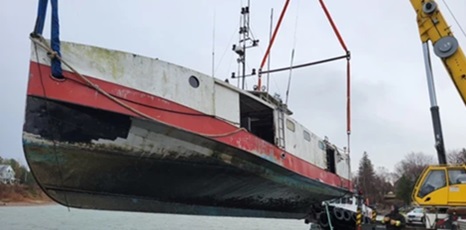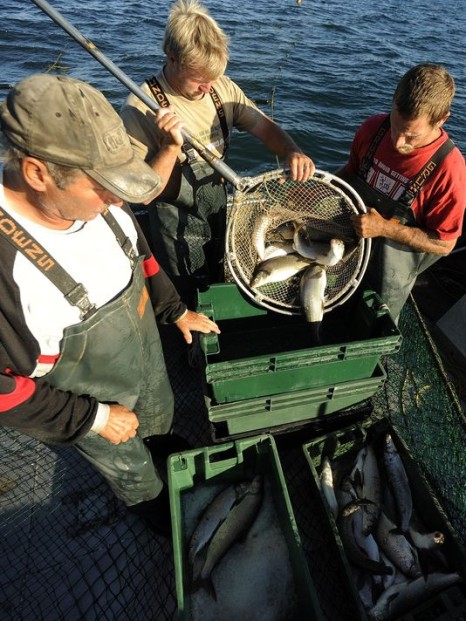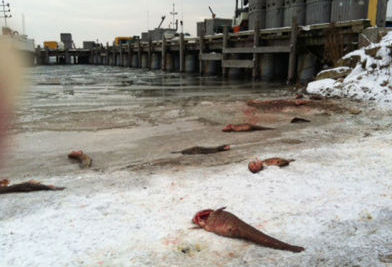Tag Archives: Lake Huron
Salvage efforts remove fishing tug from Stokes Bay waters
 The Coast Guard refloated the FV Gary M at the Stokes Bay dock for the second time in less than three months, but this time it was taken to Southampton and put on dry land. The fishing tug was lifted out on Nov. 26, as shown in a Coast Guard photo, and was placed on the government pier in Southampton, at the mouth of the Saugeen River. It was reported partly sunk Nov. 20 in Stokes Bay. It remained in Southampton Thursday. more, >>CLICK TO READ<<
The Coast Guard refloated the FV Gary M at the Stokes Bay dock for the second time in less than three months, but this time it was taken to Southampton and put on dry land. The fishing tug was lifted out on Nov. 26, as shown in a Coast Guard photo, and was placed on the government pier in Southampton, at the mouth of the Saugeen River. It was reported partly sunk Nov. 20 in Stokes Bay. It remained in Southampton Thursday. more, >>CLICK TO READ<<
Cleanup, investigation underway after fishing boat sinks at Stokes Bay
 The Canadian Coast Guard confirmed Friday that a diesel spill is being cleaned up after the Coast Guard responded to a report of a fishing boat sinking at Stokes Bay dock on the Bruce Peninsula. Pollution containment equipment encircles the vessel, while crews are working to remove pollutants using specialized equipment, the Coast Guard said by email in response to Sun Times questions Friday afternoon. The vessel was reported sinking Thursday. “The size of the spill and plan for vessel recovery are yet to be determined. The CCG conducted a helicopter overflight for aerial pollution observation, and CCG personnel remain on location today to monitor the spill site.” more, >>CLICK TO READ<< 09:55
The Canadian Coast Guard confirmed Friday that a diesel spill is being cleaned up after the Coast Guard responded to a report of a fishing boat sinking at Stokes Bay dock on the Bruce Peninsula. Pollution containment equipment encircles the vessel, while crews are working to remove pollutants using specialized equipment, the Coast Guard said by email in response to Sun Times questions Friday afternoon. The vessel was reported sinking Thursday. “The size of the spill and plan for vessel recovery are yet to be determined. The CCG conducted a helicopter overflight for aerial pollution observation, and CCG personnel remain on location today to monitor the spill site.” more, >>CLICK TO READ<< 09:55
Bay Port Fishing Company: A 128-year legacy in Huron County
 For the last 128 years, the Bay Port Fishing Company has been on the mountaintop, withstood troubling times, and still provided fresh fish year-round to the residents of Huron County and beyond. The Bay Port Fishing Company was established in 1895 off the dock of Bay Port between Lake Huron and Saginaw Bay, by W.J. Orr and W.H. Wallace. During the early years, fisherman used sailboats to make runs, placing and tending their nets. During the winter months, they chopped holes through the ice to continue fishing and preserving the catches in salt and packed them up in kegs. Photos, more, >>click to read<< 10:12
For the last 128 years, the Bay Port Fishing Company has been on the mountaintop, withstood troubling times, and still provided fresh fish year-round to the residents of Huron County and beyond. The Bay Port Fishing Company was established in 1895 off the dock of Bay Port between Lake Huron and Saginaw Bay, by W.J. Orr and W.H. Wallace. During the early years, fisherman used sailboats to make runs, placing and tending their nets. During the winter months, they chopped holes through the ice to continue fishing and preserving the catches in salt and packed them up in kegs. Photos, more, >>click to read<< 10:12
Soo Tribe says it will appeal Great Lakes commercial fishing deal
 The Sault Ste. Marie Tribe of Chippewa Indians says it will appeal an agreement struck between four other tribes, federal regulators and state of Michigan to govern Great Lakes commercial and sport fishing. The tribe said Monday, Oct. 9 that it would appeal the agreement, which was approved by a federal judge on Aug. 24, with the U.S. Sixth Circuit court of appeals by Oct. 23. The tribe did not join the agreement, which was reached in December between the state and federal governments, and the Bay Mills Indian Community, the Grand Traverse Band of Ottawa and Chippewa, the Little River Band of Ottawa and Little Traverse Bay Bands of Odawa. The agreement divvies up fishing rights in parts of lakes Michigan, Huron and Superior; extending until 2047 a longstanding regulatory framework which has been under negotiation since it expired in 2020. The deal covers Great Lakes that fall within Michigan waters in which the tribes reserve fishing rights per the 1836 Treaty of Washington. >>click to read<< 18:29
The Sault Ste. Marie Tribe of Chippewa Indians says it will appeal an agreement struck between four other tribes, federal regulators and state of Michigan to govern Great Lakes commercial and sport fishing. The tribe said Monday, Oct. 9 that it would appeal the agreement, which was approved by a federal judge on Aug. 24, with the U.S. Sixth Circuit court of appeals by Oct. 23. The tribe did not join the agreement, which was reached in December between the state and federal governments, and the Bay Mills Indian Community, the Grand Traverse Band of Ottawa and Chippewa, the Little River Band of Ottawa and Little Traverse Bay Bands of Odawa. The agreement divvies up fishing rights in parts of lakes Michigan, Huron and Superior; extending until 2047 a longstanding regulatory framework which has been under negotiation since it expired in 2020. The deal covers Great Lakes that fall within Michigan waters in which the tribes reserve fishing rights per the 1836 Treaty of Washington. >>click to read<< 18:29

‘There’s no future in it’: Parry Sound commercial fishers given ever-decreasing catch limits
Earlier this year, the Ministry of Natural Resources and Forestry announced it was “modernizing” the commercial fishery, including a move toward fishers digitally reporting their daily catch. “They just keep taking (our quota) away,” said Sandra LePage of Nobel, who owns B. LePage Fishery with her husband, Bernie, (whose father founded the famous fish restaurant Henry’s). In 2018, the LePage Fishery was allowed to harvest 34,559 pounds of whitefish; that has dropped annually. Now, for 2023, they are allowed to harvest 20,470 pounds. For lake trout, the max was 8,128 pounds in 2018, and for 2023, it is 4,894 pounds. Commercial fisher Bill Kalwaski, who is based out of Byng Inlet, said that when the lake trout population is high, the whitefish population is down, and “without the whitefish, there is no commercial fishery in the upper great lakes,” >click to read< 18:30

Inland Fisheries: A big fight in Lansing over fishing rules on the Great Lakes
Dana Serafin still hauls in 20,000-pound boatloads of whitefish to supply regional restaurants and markets, Native whitefish, the main livelihood for Serafin and other Great Lakes commercial fishermen, have been in decline for years amid changes to the food web, replaced in Serafin’s nets by healthier populations of walleye and lake trout that he’s not allowed to keep. Chinook salmon, once a favorite of recreational anglers on lakes Michigan and Huron, have also plummeted in Lake Michigan, and all but disappeared from Lake Huron. Battles are brewing over fishing rights from recreational, commercial, Native American, and environmental group meddling. Video, >click to read< 13:41

Bill to ban catching perch for profit has Saginaw Bay fishing company worried
Despite the sunny skies and the good catch, a shadow hangs over the boat. A trio of bills in the state House would, in part, stop commercial fishing of yellow perch and impose stricter regulations on commercial fishing. That worries Lakon Williams, whose family operates Bay Port Fish Co., which is based on the western shore of the Thumb, about 40 miles northeast of Bay City. “It would take away a fishery that we’ve had rights to since the 1800s, the yellow perch fishery. It’s always been a commercial fish in Saginaw Bay for us, it’s never been taken away,” she said. Video, 50 photo’s. >click to read< 15:16

Invasive mussels challenge commercial whitefish fishing in the Great Lakes
Denise Purvis’ family began fishing the waters of northern Lake Huron off Manitoulin Island in 1882. Over the years their operation came to expect the unpredictability of a livelihood dependent on the ability to capture wild fish. Purvis came back to the family business in the mid-1990s after college. Her return home coincided with the arrival of zebra and quagga mussels into the Great Lakes. The mussels have since become synonymous with the problem of invasive species in the Great Lakes. They’ve colonized the lakes and negatively impacted their ecology. For Purvis and the dwindling number of Great Lakes commercial whitefish fishers, the fishery has fallen on hard times. >Video, photo’s click to read<10:28

The story of how salmon got to the Great Lakes, told by the man who made it happen
Close to 10 million chinook and coho salmon swim in Lake Michigan, Lake Huron and Lake Superior. There were none when Howard Tanner started as the chief of the Michigan Department of Conservation’s Fish Division in 1964. His boss, Ralph MacMullan, spent much of their first meeting lambasting the fish department for its previous lack of action and dysfunction. Heaps of dead fish were washing up on beaches, the lakes were overly commercially fished and there was little recreational fishing to speak of. He gave Tanner a mandate: “Do something. “And if you can,” he added, “make it spectacular.” By introducing salmon into the Great Lakes in the 1960s, Tanner did just that. >click to read<12:26

Lake Huron – Thriving family fishery spans 2 centuries, 5 generations
Tim Purdy gets a little emotional when he talks about his son Josiah becoming the fifth generation to work at the family fishery in Point Edward. “It’s good to see your kids want to be involved,” Purdy says. Though proud his son is part of a thriving business that’s operated for nearly 120 years, he’s worried too. “We’re trying to figure out how to stop the Asian carp,”,,, >click to read< 18:07
Great Lakes Fisheries Heritage Trail: Katherine V a lone survivor and fishing legend
 A Great Lakes gill net fish tug, the Katherine V was built in 1928 on the shores of northern Lake Huron in Rogers City by Native American builder Henry Vincent, and was fished by the Vogelheim family, who owned and operated the Katherine V from her launch until retirement in 1970. At 57 feet in length, entirely enclosed, and powered by a Kahlenberg 3-cylinder engine the tug is an example of late 19th and early 20th century Great Lakes commercial fishing vessels. Constructed of white oak, northern white cedar and cypress, the boat was eventually sheathed in steel and aluminum early in its fishing career to aide in fishing through the winter. Read the rest here 19:27
A Great Lakes gill net fish tug, the Katherine V was built in 1928 on the shores of northern Lake Huron in Rogers City by Native American builder Henry Vincent, and was fished by the Vogelheim family, who owned and operated the Katherine V from her launch until retirement in 1970. At 57 feet in length, entirely enclosed, and powered by a Kahlenberg 3-cylinder engine the tug is an example of late 19th and early 20th century Great Lakes commercial fishing vessels. Constructed of white oak, northern white cedar and cypress, the boat was eventually sheathed in steel and aluminum early in its fishing career to aide in fishing through the winter. Read the rest here 19:27
The first year of a three-year experiment allowing commercial fishing for whitefish in southern Lake Huron is wrapping up.
Tom Goniea, the administrator for the Michigan Department of Natural Resources’ commercial fishing program, said  of Pinconning had collapsed his trap nets before pulling them. “He’s done for the season now,” Goniea said. “I was out on his boat (Oct. 26) when he did his last set of the year.” Goniea said the experiment likely will continue in 2016. “I see no reason why it wouldn’t at this point,” he said. “He was relatively successful this year considering the fact he missed the first two months of the season. Read the rest here 09:43
of Pinconning had collapsed his trap nets before pulling them. “He’s done for the season now,” Goniea said. “I was out on his boat (Oct. 26) when he did his last set of the year.” Goniea said the experiment likely will continue in 2016. “I see no reason why it wouldn’t at this point,” he said. “He was relatively successful this year considering the fact he missed the first two months of the season. Read the rest here 09:43
Michigan Considers Controversial Commercial Net-Pen Aquaculture in Huron and Michigan
 Several State agencies are looking at proposals to allow commercial net-pen aquaculture on the Great Lakes. The practice is controversial because of environmental concerns. WDET’s Amy Miller spoke with Tammy Newcomb; Senior Policy Advisor for the Department of Natural Resources. She says Ontario has allowed a few net-pens near Georgian Bay and now there are two Michigan proposals. This week the State is holding two public hearings on the two Great Lakes net-pen aquaculture proposals. Listen to the report here 08:29
Several State agencies are looking at proposals to allow commercial net-pen aquaculture on the Great Lakes. The practice is controversial because of environmental concerns. WDET’s Amy Miller spoke with Tammy Newcomb; Senior Policy Advisor for the Department of Natural Resources. She says Ontario has allowed a few net-pens near Georgian Bay and now there are two Michigan proposals. This week the State is holding two public hearings on the two Great Lakes net-pen aquaculture proposals. Listen to the report here 08:29
Commercial fishing trial worries Lake Huron anglers
 When the Michigan Department of Natural Resources announced a three-year trial to allow a commercial fishery to pursue whitefish in southern Lake Huron, recreational anglers took to social media to express their outrage. The state also is hoping that by allowing the commercial fisherman, Dana Serafin, to move his operation to southern Lake Huron, some of the fishing pressure in Saginaw Bay will be relieved. the state also announced a panel to look at the possible effects of proposals to raise fish in net pens in the Great Lakes. Read the rest here 20:30
When the Michigan Department of Natural Resources announced a three-year trial to allow a commercial fishery to pursue whitefish in southern Lake Huron, recreational anglers took to social media to express their outrage. The state also is hoping that by allowing the commercial fisherman, Dana Serafin, to move his operation to southern Lake Huron, some of the fishing pressure in Saginaw Bay will be relieved. the state also announced a panel to look at the possible effects of proposals to raise fish in net pens in the Great Lakes. Read the rest here 20:30
Michigan Department of Natural Resources considers commercial fishing in Lake Huron
 Michigan is exploring the possibility of commercial fishing for whitefish in southern Lake Huron. The state Department of Natural Resources says it issued a research permit to a commercial fisher to explore populations. Starting this month, large mesh trap nets will be allowed in experimental fishing grounds several miles south of Harbor Beach and north of Port Sanilac. The Michigan waters of southern Lake Huron haven’t been commercially fished in five decades, but commercial fishing is established in Canadian waters. Read the rest here 10:50
Michigan is exploring the possibility of commercial fishing for whitefish in southern Lake Huron. The state Department of Natural Resources says it issued a research permit to a commercial fisher to explore populations. Starting this month, large mesh trap nets will be allowed in experimental fishing grounds several miles south of Harbor Beach and north of Port Sanilac. The Michigan waters of southern Lake Huron haven’t been commercially fished in five decades, but commercial fishing is established in Canadian waters. Read the rest here 10:50
Few native fishing complaints valid: MNRF
It’s too early to say much about an allegation that commercial fishermen may be responsible for the presence of 14 fish found on shore,,,  Chief Vern Roote said Friday in an interview that racism fuels a lot of people who “nitpick” about the commercial fishery, which is controlled by the Saugeen Ojibway Nation. Read the rest here 19:25
Chief Vern Roote said Friday in an interview that racism fuels a lot of people who “nitpick” about the commercial fishery, which is controlled by the Saugeen Ojibway Nation. Read the rest here 19:25
Finns visit Michigan to learn about Great Lakes trap net fishing
 After spending time with Michigan commercial fishermen, a Finnish delegation returns home with new techniques and knowledge to begin to create a thriving new fishery in their home country. continued
After spending time with Michigan commercial fishermen, a Finnish delegation returns home with new techniques and knowledge to begin to create a thriving new fishery in their home country. continued










































